Even though fat-tire snow bikes have become increasingly popular in Alaska, their cartoonish proportions still garner quizzical looks from the locals.
The six of us had created an impressive yard sale while gearing up for a weeklong tour at the Wickersham Dome Trailhead. A handful of Carhartt-clad dog mushers watched in amusement as they hooked up their teams. The pups where also distracted as we put together the puzzle of frame, seat and handle-bar bags that would carry our supplies (four bottles of spirits and a box of wine) on our ride. With everyone eventually in the saddle, we rolled onto the skinny trail that headed into the scraggly forest of black spruce. Before us was a three-foot-wide ribbon of packed snow that cut across the rolling hills to the horizon. Before week’s end, we would close a hundred-mile loop back to this spot. Rather than the primo singletrack we all seek out, this was primo crisp snowtrack.
Located 30 miles north of Fairbanks, Alaska, on the Elliott Highway, the one-million-acre White Mountains National Recreation Area is a multi-use nirvana. The Bureau of Land Management maintains more than 200 miles of winter trails that are open to sled dogs, snowmobiles, bikers and skiers. The trail network also connects a dozen log cabins available to the public on a reservation system. Having these wood-heated huts is key to doing multiday trips in Alaska’s interior where it routinely gets forty below, or colder, at night. Our tour utilized five of the cabins, going as far out as the Windy Gap Cabin, about 50 miles from our starting point. There’s little to no artificial light pollution in the Whites and the extreme cold makes the night air razor sharp. This makes it one of the best spots in AK to sip whiskey and watch the northern lights dance across the sky.
It’s also one of the best places on the planet to snow bike.
DIY Logistics
White Mountains National Recreation Area is run by the U.S. Bureau of Land Management and is best traveled during the winter months. The BLM maintains three trailheads to provide access to 12 public recreation cabins that are connected by extensive trail systems. Trailheads for the Wickersham Creek Trail and the Colorado Creek Trail are provided at milepost 28 and 57 Steese Highway, respectively, and more remotely, the McKay Creek Trail is accessed from milepost 42.5 Steese Highway. The average distance between cabins is approximately 10 miles. Permits range from $20 to $25 per night and are required in advance. Please check on cabin availability as the White Mountains area has suffered from wildfires over the past years resulting in the loss of cabins. To find out more about permits, cabin locations and trail conditions, visit the BLM’s website.
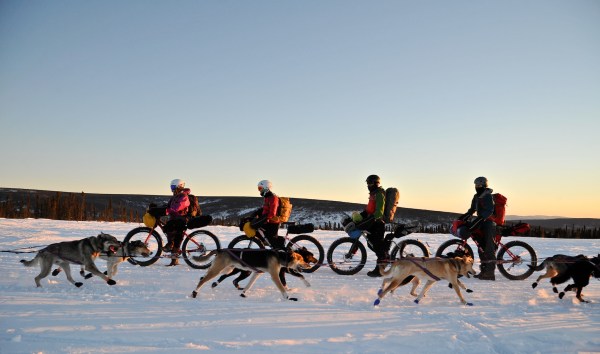
Our crew yields the trail to a team of sled dogs on the Trail Creek Trail on our way to Moose Creek Cabin. The White Mountains are truly a multi-use area and you can expect to share the trails with local dog mushers, snowmobiles, Nordic skiers and the occasional wolf pack.

With the sun setting and temperature dropping, everyone was stoked to finally reach the Moose Creek Cabin at the end of our first day. The BLM replaced the rough and rustic 1986 shelter with a new log cabin over the summer.

Brad and Christine take a turn at breakfast duty on the complimentary two-burner at the Moose Creek Cabin. Each cabin comes equipped with rudimentary items for cooking, allowing us to spruce up our menu from the superlight freeze-dried meals we normally carry. Just ask Brad; Alaska-based Adventure Appetites reindeer Gouda scramble hits the spot on a sub-Arctic morning.

Christine takes advantage of a heavy load for a gravity assist down into Beaver Creek. The BLM maintains over 200 miles of snow track in the White Mountains, most of it kept firm by snowmobile traffic.
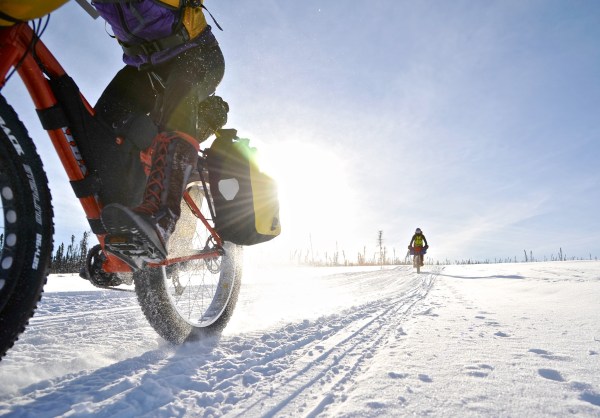
Christine likes that sound your tires make when sizzling down a few hundred feet of firm snow track. Brad just tries to keep up.
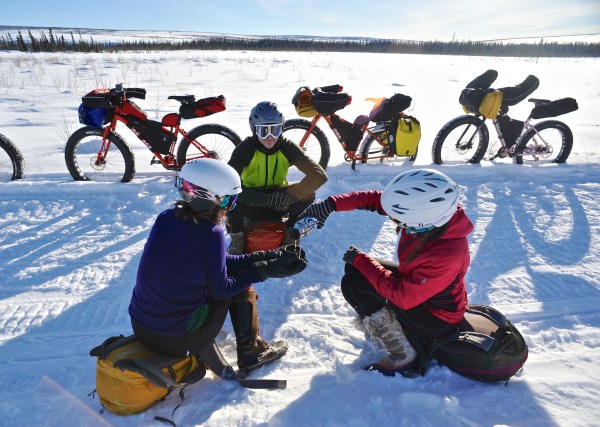
Snow Track Fact: Your feet won’t warm up until you get off the bike. None of us knows the reasoning behind this. But we’d take frequent trail stops to warm our feet with hot drinks or two-minute dance parties.
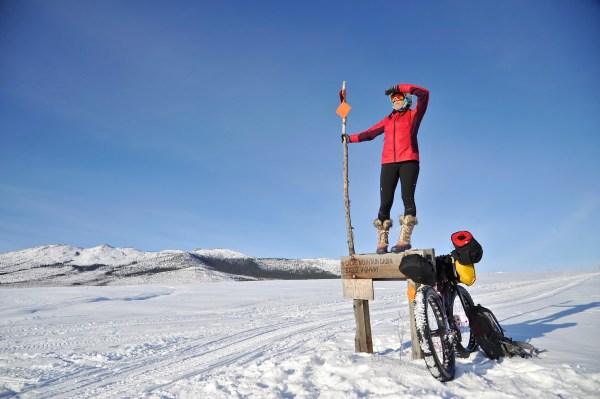
Agnes (of the North) sees what she can see (a helluva lot of snow) on the Cache Mountain Loop Trail. Junctions are well marked throughout the 250-mile network, but we’re not so sure about the mileages.

Sub-Arctic Truth: They who cut their own firewood, warm themselves twice. Agnes and Brad take turns on the axe that can be found, along with a saw, at each cabin. The BLM also tries to keep each supplied with wood as well.
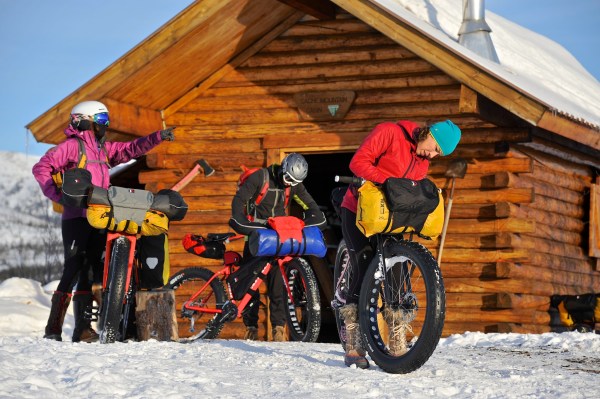
The team gears up for the week’s big day at the Cache Mountain Cabin: 23 miles up and over Cache Mountain Divide (3,285 feet) to Windy Gap Cabin. This will mark the halfway point of our tour, putting us about 50 miles from the Elliott Highway.
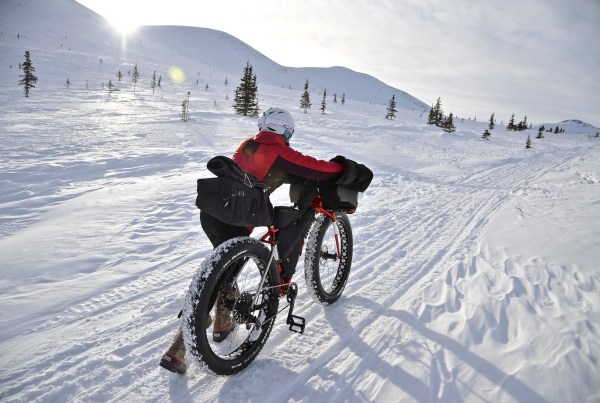
Agnes opts for the bike push when the track becomes too soft to ride near the top of 3,285-foot Cache Mountain Divide. The mountain pass had seen some recent drifting and which felt like trying to ride uphill in four inches of sugar. The backside was a steep downhill run, descending a semi-firm track that would change to unconsolidated depth hoar with no warning. The endos were spectacular.
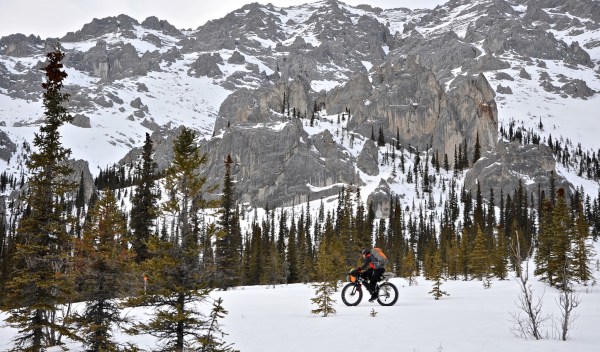
Jaime pedals the Fossil Creek Trail beneath the vast limestone formations that form the backbone of the White Mountains. Part of the Limestone Jags Research Natural Area, these cliffs are full of caves and fossils.
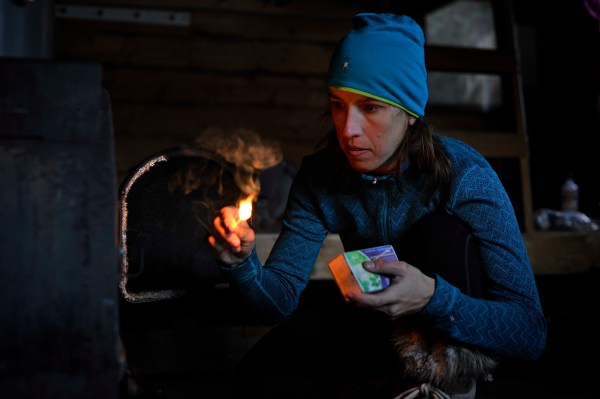
All 12 of the cabins maintained by the BLM rely on wood heat. And after a day of riding at 20 below, getting a fire going is top priority upon arrival. Agnes lights it up at the Windy Gap Cabin.

Brad packs up his gear at the Windy Gap Cabin, the halfway point of our 100-mile tour. Decked out with seat, frame and handle-bar bags from Revelate Design, we were able to carry warm winter clothes, sleeping bags, and a week’s worth of groceries.
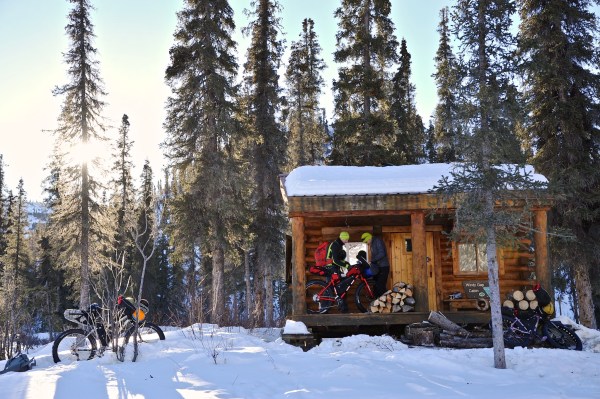
Brad and Jaime make last minute adjustments to their loads before hitting the trail from the Windy Gap Cabin.
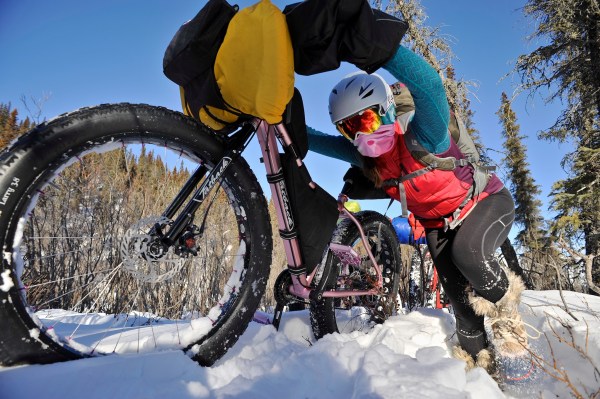
The track disappeared and overflow on Fossil Creek forced us to improvise a new route through the spruce forest. Agnes savors the winter off-track experience.
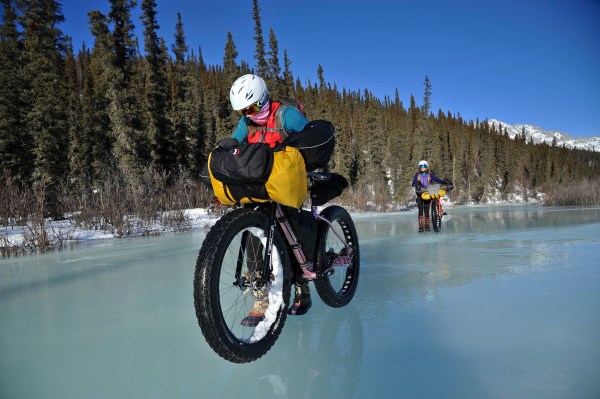
Agnes and Christine gingerly roll their bikes over the water-slick ice of Fossil Creek. The snow track follows the creek, but was buried deep under the buildup of overflow ice. Sure is pretty, though.
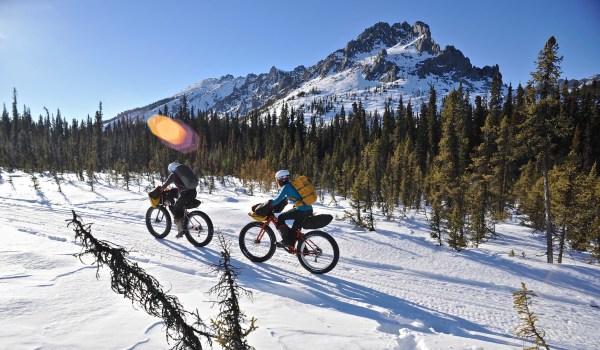
Agnes and Christine ride the Fossil Creek Trail between the Windy Gap and Borealis–LeFevre Cabin. Overlooking the limestone spires of what’s known as Big Bend, it’s a spectacular section of our hundred-mile loop.
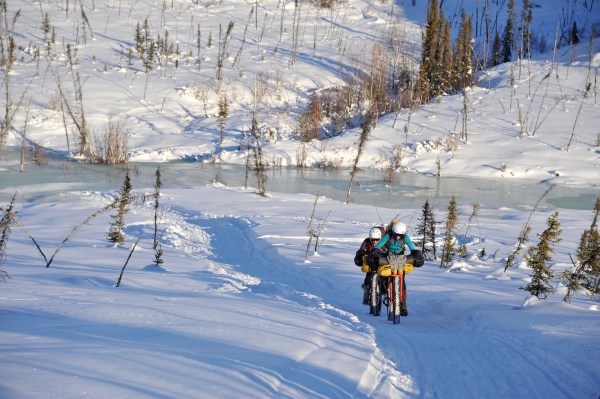
After battling through a stretch of breakable ice and overflow, Agnes and Christine climb above Fossil Creek. Overflow ice builds up while trapping frigid ground water in between breakable layers. Step in the wrong spot and you’re guaranteed to get a boot full of ice water. Not ideal when you’re still 10 miles from the cabin.
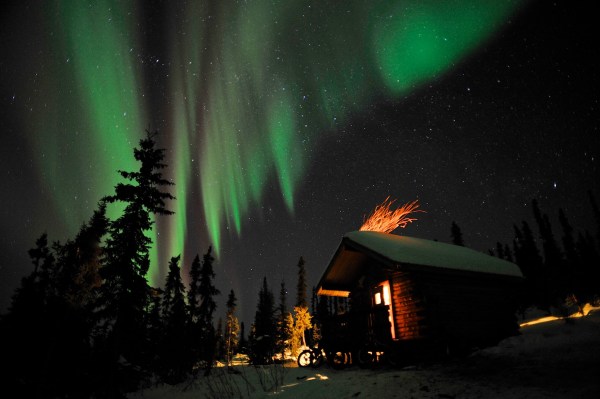
The northern lights dance above the Borealis–LeFevre Cabin on the final night of our weeklong tour. Far from artificial light sources, the White Mountains are a renowned place to catch the aurora borealis. Cold, clear nights are plentiful in Alaska’s interior.
